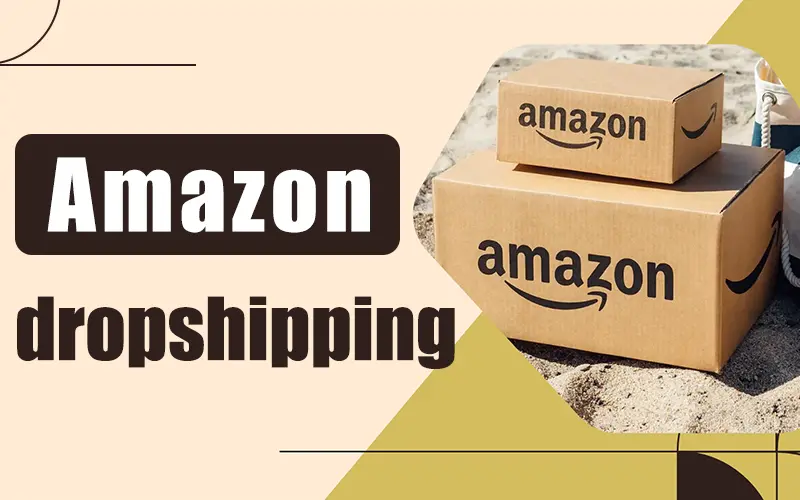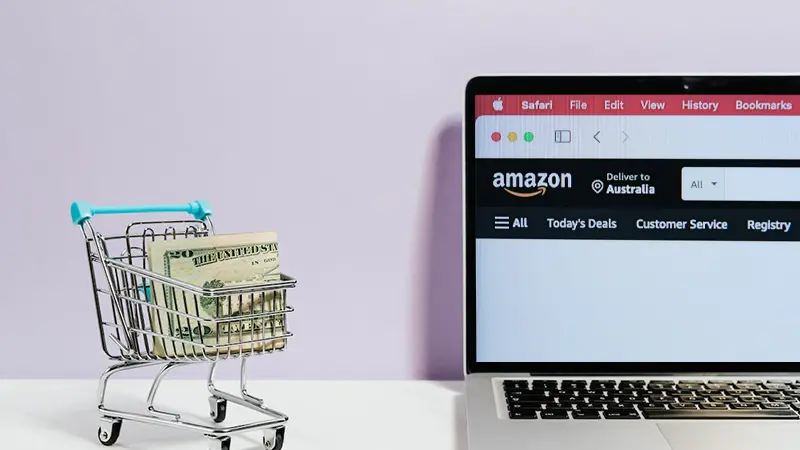Amazon dropshipping is an excellent business model for entrepreneurs looking to enter the e-commerce sphere. By leveraging Amazon’s vast customer base and sophisticated platform, sellers can list products for sale and, upon receiving an order, purchase the item from a third party that ships it directly to the customer. This approach minimizes upfront costs and risks associated with inventory management.
However, navigating the intricacies of Amazon’s dropshipping policies and finding the right products and niches are critical steps for achieving success. This guide provides an overview of Amazon dropshipping, covering everything from adhering to Amazon’s policies to selecting profitable products and niches, setting the stage for aspiring entrepreneurs to thrive in this competitive market.

Page overview:
What is Amazon Dropshipping Policies?
Finding Profitable Products and Niches
Step 1 – Identify High-Demand Products on Amazon
Step 2 – Evaluate Product Profitability and Market Trends
Step 3 – Select a Niche for Long-Term Success
Setting Up Your Amazon Dropshipping Business
Creating a Professional Seller Account on Amazon
Establishing Reliable Supplier Relationships
Integrating Dropshipping Tools for Efficiency
Optimizing Product Listings for Conversions
Crafting SEO-Friendly Product Titles
Writing Persuasive Product Descriptions
Price Management and Competitive Strategies
Leveraging Amazon Advertising for Dropshipping Growth
Exploring Amazon Sponsored Products and Ads
Analyzing Advertising Data for Continuous Improvement
What is Amazon Dropshipping Policies?
Amazon’s dropshipping policy allows sellers to use this business model but with strict guidelines to ensure customer satisfaction and compliance. The primary rule is that you must be the seller of record for your products, and any packing slips, invoices, and other information related to the shipment must identify you as the seller. Amazon also mandates that sellers remove any third-party packing slips, invoices, or additional information that could confuse customers about who is selling the product.

Common Pitfalls and Mistakes to Avoid
- Not Being the Seller of Record: One of the most common mistakes is not ensuring that the seller’s name and contact information are on the packing slip and invoice. This can lead to customer confusion and issues with Amazon.
- Failing to Fulfill Orders Promptly: Amazon requires sellers to fulfill orders according to the shipping times stated on their Amazon seller page. Delays can result in penalties or suspension.
- Ignoring Quality Control: Since the seller does not handle the product directly, there’s a risk of shipping subpar products. It’s crucial to work with reliable suppliers who uphold product quality.
- Violating Amazon’s Policies: Amazon has specific requirements for dropshipping, including prohibitions against purchasing products from another retailer and shipping them directly to customers. Violating them can lead to account suspension.
Finding Profitable Products and Niches
Wondering how to dropship on Amazon? The first step is finding products and niches that ensure profitability. Remember, the key to success in Amazon dropshipping lies in diligent research and a customer-centric approach. Here’s how to find profitable products and niches for dropshipping on Amazon in three steps.
Step 1 – Identify High-Demand Products on Amazon
To succeed in Amazon dropshipping, start by identifying products in high demand. Utilize Amazon’s Best Sellers list, watch for trends, and use tools like Jungle Scout or Helium 10 to analyze sales data and competition. Products with high demand but not overly saturated with competitors can be ideal.
Step 2 – Evaluate Product Profitability and Market Trends
Profitability isn’t just about demand; it also involves evaluating potential profit margins. Consider product costs, shipping costs, and Amazon fees to ensure a product is financially viable. Additionally, stay on top of market trends to anticipate shifts in consumer demand, allowing you to adapt your inventory accordingly.
Step 3 – Select a Niche for Long-Term Success
Choosing a niche involves identifying areas where you can establish authority and brand recognition. Look for niches that match your interests or expertise, as this can make marketing and product selection more intuitive. Consider niches with a loyal customer base and the potential for repeat purchases, as these can offer long-term stability and growth opportunities.
Setting Up Your Amazon Dropshipping Business
Embarking on an Amazon dropshipping journey requires careful planning and execution. Once you have selected your products, it’s time to set up your seller account, establish relationships with reliable suppliers, and leverage dropshipping tools to streamline your operations. We will guide you through these critical phases to ensure a solid foundation for your dropshipping business.
Creating a Professional Seller Account on Amazon
A Professional Seller account on Amazon allows you to access advanced selling tools and analytics, which are essential for managing and scaling your business. Here’s how to set it up:
- Visit Amazon Seller Central: Create a new account by navigating to Amazon Seller Central.
- Choose ‘Professional’: Opt for the Professional seller plan. While there is a monthly fee, it provides access to necessary features for serious sellers, including bulk listing and inventory management tools.
- Provide Your Business Information: Fill in your business details, including your legal business name, address, and tax identification number. Amazon requires this information to verify your business.
- Set Up Payment Information: Enter your bank account details. Amazon will use this account to deposit your sales earnings.
- Complete the Verification Process: Amazon will verify your information, which may include a phone call or requesting additional documentation.
Establishing Reliable Supplier Relationships
A successful dropshipping business hinges on having dependable suppliers who can provide high-quality products and fulfill orders efficiently. Here’s how to establish and maintain these crucial relationships:
- Research Potential Suppliers: Look for suppliers with great reviews, highlighting their reliable service and product quality, such as EPROLO. Trade shows, wholesale directories, and industry forums are some other excellent resources.
If you want to start Amazon dropshipping and boost your sales, try EPROLO. EPROLO is a professional supply chain platform, specializing in dropshipping (no membership fee), inventory management, brand building and more.
- Evaluate Their Products and Services: Request samples to assess product quality. Also, evaluate their shipping times, return policies, and customer service. Regular check-ins can also help preempt issues with inventory or order fulfillment.

Integrating Dropshipping Tools for Efficiency
Dropshipping tools can significantly enhance your efficiency by automating various aspects of your business, from product sourcing to order fulfillment. Here are some tools and how they can benefit your business:
- Product Research Tools (e.g.,Jungle Scout , Helium 10): These tools help identify profitable products and niches by providing sales data, competition levels, and market trends.
- Inventory Management Software: Use software or platforms that automate inventory updates, helping you avoid selling products that are out of stock with your supplier. Also, consider automating the order fulfillment process by integrating tools that connect your Amazon orders with your suppliers, ensuring orders are promptly forwarded for shipping.
Optimizing Product Listings for Conversions
A well-optimized product listing is crucial for encouraging customers to make a purchase. Here are strategies to enhance your product listings for higher conversions:
Crafting SEO-Friendly Product Titles
Product titles are the first thing customers see, so it’s essential to make them both informative and SEO-friendly to improve visibility and click-through rates. Here’s how:
- Use Relevant Keywords: Research keywords that potential customers use to search for products like yours. Incorporate them into your titles to improve search rankings on Amazon.
- Highlight Key Features: Include important details such as brand, size, quantity, and color in the title. This helps customers quickly understand what you’re selling and can improve match accuracy in search results.
- Keep It Clear and Concise: While including keywords and details is important, avoid cluttering your title. Aim for clarity to ensure that customers can easily comprehend the product at a glance.

Writing Persuasive Product Descriptions
A compelling product description can significantly influence a customer’s decision to purchase. Focus on the following aspects:
- Benefits Over Features: While listing product features is important, translating those features into tangible benefits for the customer can be more persuasive. Make sure to talk about how your products solve a problem.
- Use Bullet Points for Key Information: Bullet points make your description easier to scan, allowing customers to quickly gather essential information about the product.
- Incorporate Keywords: Like your title, include relevant keywords in your description to improve SEO. However, ensure the text remains natural and engaging.
Price Management and Competitive Strategies
Pricing is a critical factor in Amazon’s competitive world. Employing dynamic pricing strategies and keeping an eye on competitor prices can help you stay competitive and maximize profits. Dynamic pricing involves adjusting your product prices based on market demand, competitor prices, and other factors. Here’s how to implement it effectively:
- Use Pricing Software: Employ smart tools and software to automate price adjustments based on predefined rules and real-time market data. This ensures your prices are always competitive without constant manual oversight.
- Consider Your Costs and Margins: While staying competitive is crucial, ensure your pricing strategy covers your costs and leaves room for profit. Factor in Amazon fees, shipping costs, and any other expenses.
- React Strategically to Price Changes: If competitors change their prices, consider why they might have done so before adjusting your prices. Sometimes, maintaining your price is more beneficial for positioning your product as premium quality.
Leveraging Amazon Advertising for Dropshipping Growth
Amazon Advertising offers powerful tools to increase visibility and drive sales for your dropshipping products. By strategically using Amazon Sponsored Products and analyzing advertising data, you can significantly boost your growth on the platform.
Exploring Amazon Sponsored Products and Ads
Amazon Sponsored Products and other advertising solutions provide a direct way to place your products in front of more potential customers. Here’s how to leverage these tools effectively:
- Amazon Sponsored Products: This advertising option allows you to promote individual product listings on Amazon, helping you reach shoppers actively looking for products like yours. To get started, select the products you want to advertise, choose your target keywords, and set your budget.
- Amazon Sponsored Brands and Sponsored Display Ads: For broader visibility, consider Sponsored Brands to promote your brand and multiple products through customizable ads in search results. With Sponsored Display Ads, you can reach customers on and off Amazon based on their interests and shopping behavior.
Analyzing Advertising Data for Continuous Improvement
The key to successful Amazon Advertising lies in analyzing performance data and continuously optimizing your campaigns:
- Review Advertising Reports: Amazon provides detailed reports on the ads, including metrics like impressions, clicks, conversion rate, and ACoS (Advertising Cost of Sale). Regularly reviewing these reports helps you understand what’s working and what isn’t.
- Optimize Your Campaigns: Use the insights from your advertising reports to make informed decisions on how to improve your campaigns. This might involve adjusting your bids, refining your target keywords, or reallocating your budget to more successful ads.
Amazon Dropshipping: Conclusion
With the right knowledge, you can establish a successful Amazon dropshipping venture. From understanding Amazon’s dropshipping policies to optimizing your product listings and leveraging Amazon Advertising, we’ve covered the essential steps on how to dropship with Amazon effectively.
However, keep in mind that the key to success in Amazon dropshipping lies in continuous learning, adaptation, and optimization. By staying informed about Amazon’s evolving policies, keeping a close eye on market trends, and consistently refining your approach, you can build a thriving dropshipping business.
As you move forward, keep experimenting with new strategies, exploring profitable niches, and enhancing your advertising efforts. Here’s to your success in mastering how to dropship with Amazon and turning your entrepreneurial dreams into reality!
Amazon Dropshipping: FAQs
Is Amazon dropshipping profitable?
Yes, Amazon dropshipping can be profitable if managed correctly. Success mainly depends on selecting the right products, establishing good supplier relationships, optimizing listings, and using effective pricing and advertising strategies.
Do I need to inform Amazon that I am dropshipping?
Yes, you must comply with Amazon’s dropshipping policy, which includes being the seller of record, ensuring that your supplier does not send any materials, including their own details, with the shipments, and accepting and processing customer returns.
Can I use any supplier for Amazon dropshipping?
While you can choose your suppliers, it’s crucial to ensure they are reliable. Amazon holds you accountable for the customer experience, so your supplier’s performance directly affects your business reputation on Amazon. Opt for reliable suppliers such as EPROLO.
How much money do I need to start dropshipping on Amazon?
The startup costs for Amazon dropshipping can be relatively low since you don’t need to purchase inventory upfront. However, you will need money for an Amazon Professional Seller account, any dropshipping software or tools you choose to use, and funds for marketing and advertising.
How can I ensure my dropshipping business complies with Amazon’s policies?
Regularly review Amazon’s dropshipping policies and maintain open communication with your suppliers to ensure they meet Amazon’s requirements.







